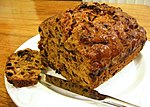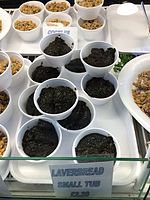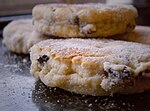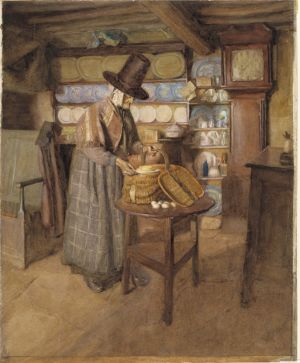
The culture of Wales is distinct, with its own language, customs, festivals, music, art, mythology, history, and politics. Wales is primarily represented by the symbol of the red Welsh Dragon, but other national emblems include the leek and the daffodil.

Toad in the hole is a traditional English dish consisting of sausages in Yorkshire pudding batter, usually served with onion gravy and vegetables. Historically, the dish has also been prepared using other meats, such as rump steak and lamb's kidney. In the 21st century, vegetarian and vegan versions have appeared.

Cheesecake is a dessert made with a soft fresh cheese, eggs, and sugar. It may have a crust or base made from crushed cookies, graham crackers, pastry, or sometimes sponge cake. Cheesecake may be baked or unbaked, and is usually refrigerated.
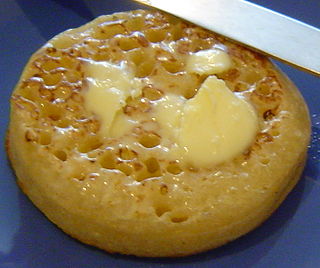
A crumpet is a small griddle bread made from an unsweetened batter of water or milk, flour, and yeast, popular in the United Kingdom, Australia, Canada, New Zealand, and South Africa.

The crempog is a Welsh pancake made with flour, buttermilk, eggs, vinegar and salted butter. Traditionally made on bakestones or griddles, the crempog is one of the oldest recipes in Wales. They are also known as ffroes, pancos and cramoth and are normally served thickly piled into a stack and spread with butter. It is traditionally served at celebrations in Wales, such as Shrove Tuesday and birthdays.
Anglo-Indian cuisine is the cuisine that developed during the British Raj in India. The cuisine introduced dishes such as curry, chutney, kedgeree, mulligatawny and pish pash to English palates.

Eliza Acton was an English food writer and poet who produced one of Britain's first cookery books aimed at the domestic reader, Modern Cookery for Private Families. The book introduced the now-universal practice of listing ingredients and giving suggested cooking times for each recipe. It included the first recipes in English for Brussels sprouts and for spaghetti. It also contains the first recipe for what Acton called "Christmas pudding"; the dish was normally called plum pudding, recipes for which had appeared previously, although Acton was the first to put the name and recipe together.
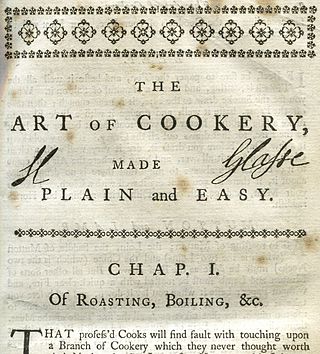
Hannah Glasse was an English cookery writer of the 18th century. Her first cookery book, The Art of Cookery Made Plain and Easy, published in 1747, became the best-selling recipe book that century. It was reprinted within its first year of publication, appeared in 20 editions in the 18th century, and continued to be published until well into the 19th century. She later wrote The Servants' Directory (1760) and The Compleat Confectioner, which was probably published in 1760; neither book was as commercially successful as her first.
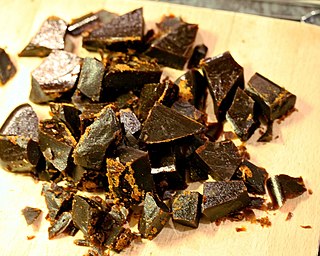
Bonfire toffee is a hard, brittle toffee associated with Halloween and Guy Fawkes Night in the United Kingdom. The toffee tastes very strongly of black treacle (molasses), and cheap versions can be quite bitter. In Scotland, the treat is known as claggum, with less sweet versions known as clack. In Wales, it is known as loshin du. The flavour is similar to that of butterscotch.

Glamorgan sausage is a traditional Welsh vegetarian sausage for which the main ingredients are cheese, leeks and breadcrumbs. It is named after the historic county of Glamorgan in Wales.

The Bath bun is a sweet roll made from a milk-based yeast dough with crushed sugar sprinkled on top after baking. Variations in ingredients include enclosing a lump of sugar in the bun or adding candied fruit peel, currants, raisins or sultanas.

Shish kebab or shish kebap is a popular meal of skewered and grilled cubes of meat. It can be found in Mediterranean cuisine and is similar to or synonymous with dishes called shashlik and khorovats, found in the Caucasus region.

Figgy pudding or fig pudding is any of many medieval Christmas dishes, usually sweet or savory cakes containing honey, fruits and nuts. In later times, rum or other distilled alcohol was often added to enrich the fruitiness of the flavour.

Elizabeth Raffald was an English author, innovator and entrepreneur.

Welsh cuisine encompasses the cooking styles, traditions and recipes associated with Wales. While there are many dishes that can be considered Welsh due to their ingredients and/or history, dishes such as cawl, Welsh rarebit, laverbread, Welsh cakes, bara brith and Glamorgan sausage have all been regarded as symbols of Welsh food. Some variation in dishes exists across the country, with notable differences existing in the Gower Peninsula, a historically isolated rural area which developed self-sufficiency in food production.
Tharida is a soup in Arab cuisine prepared with broth, stewed meat and bread crumbs that are crumbled using one's fingers; the bread crumbs serve to thicken the soup. It was sometimes prepared using brains for the meat. Additional ingredients that can be used include beans, crushed or pounded walnuts, yogurt, mint and spices. It may have a milky appearance. Hundreds of variations and recipes exist for the dish.

Bobby Freeman was a writer, journalist, television presenter and cook who is known for her writing on Welsh cuisine.

Martha Bradley was a British cookery book writer. Little is known about her life, except that she worked as a cook for over thirty years in the fashionable spa town of Bath, Somerset.

Beef olives are an English meat dish consisting of slices of beef rolled and tied round a stuffing and braised in stock. Veal is sometimes used instead of beef, but the latter has been more common since the 18th century. Similar dishes are familiar in cuisines of other countries including France, Italy, Germany, Poland and the Czech Republic.
